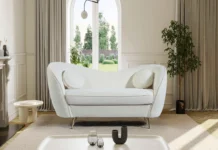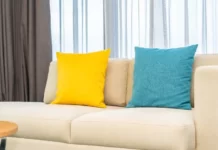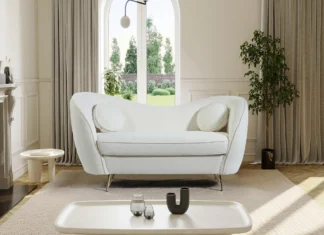Have you ever thought of getting an ottoman or hassock for your living space but not sure about the differences? Do you also consider that these two are same? If yes, this guide is for you. Let’s get the basics first.
Ottomans and hassocks are pieces of furniture that are categorized as footstools. There are no backs or armrests on these cushions or upholstered seats. The primary difference between an ottoman and a hassock is its size and form. Their applications also differ based on these physical characteristics.
What is Ottoman?
An ottoman is a furniture piece that is cushioned, upholstered seat or a bench. It is commonly used as a stool or footstool because it has no back or arms. Coffee tables may be made out of ottomans. They’re usually hollow and have storage space under the cushion, so they’re great for storing things. The wooden legs of many ottomans are not covered by cloth. They’re usually sold together with gliders or armchairs as matching furniture. Ottomans may be employed in a variety of rooms, including the bedroom, living room, family area, and gaming room.
The ottoman’s origins may be traced back to the Ottoman Empire when it was used as a low wooden platform for pillows to be placed on. In the late 18th century, this style was introduced to Europe.
What is Hassock?
Hassocks are thick, hard cushions that are used as footstools or low seats. They are typically round in shape and are smaller than ottomans. They may also be utilized as living room side tables. Hassocks, unlike ottomans, are not hollow on the interior, therefore they cannot be used as storage. Although hassocks include wooden legs to provide stiffness, these legs are completely covered in fabric. From the exterior, they look to be a huge cushions.
Since hassocks are short you may kneel on hassocks or rest on them because they are near to the ground. They’re frequently utilized in churches when the congregation kneels to pray. The hassock is sometimes called a tuffet or a pouf, although pouffes are taller and bigger.
Ottoman vs Hassock
The fundamental difference between a hassock and an ottoman is their purpose. A hassock is generally used as a leg rest or a seat, however, it does not have any storage capacity. Whereas an ottoman may be used as a storage place. Another difference is that the ottoman’s feet are bare, but the others are not.
In the most fundamental sense, both the hassock and the ottoman are footstools. They’re both upholstered and padded, but the arms and backrests are missing. The form and size of the two are one of the most striking variances. Hassocks are smaller than hassocks in general. An ottoman’s shape is often spherical.
In terms of cushioning, upholstery, and fabric or leather covering, there isn’t much difference between ottomans and hassocks. Hassocks, on the other hand, are generally fully upholstered or covered with cushioning and fabric. Their body frames as well as their legs are not visible.
Here’s a chart to help you see the changes more clearly.
What is the difference between an Ottoman and a Hassock?
| Difference | Ottoman | Hassock |
| Size | Ottomans are larger and taller than hassocks. | Hassocks are shorter and smaller than ottomans. |
| Shapes | Ottomans may take different shapes, but they are often rectangular in shape. | Hassocks are mostly round in shape. |
| Storage | Ottomans can be used as storage spaces since they are hollow. | Hassocks are not used for storage. |
| Legs | Ottomans have wooden legs which are not covered in fabric. | Hassocks may have legs, but they are always covered in fabric. |
What is Hassock Used for:
A Footstool
A hassock is an easy choice for adding a footrest to your sofa at a little deeper level. When additional ground area is required, they may be pulled to the side, and if small enough, they can be hidden behind a sofa.
A Side Table
A hassock may be used as a side table as well. With the addition of a coaster and a couple of books, you can turn your hassock into a lovely side table. Simply match the fabric type to the sofa or choose a fabric color or pattern that will stand out in the space.
A Pet Bed
If you’re a pet parent, we’re confident you’ll adore the idea of utilizing your hassock as a stylish pet bed for your furry friends. To guarantee that hassocks are pet-friendly, seek ones that are upholstered in a robust fabric that can withstand filth and hair.
What is an Ottoman Used for:
A Footstool
Footstools can be made out of ottomans. All you have to do now is pick a colour scheme that goes with your couches, and you’ll have the perfect spot to put your feet up at the end of the day.
An Extra Chair
We may find ourselves in the frustrating predicament of having more visitors than chairs available. The ottoman would be a great transition piece from a footrest to a chair.
The ottoman’s reasonable height makes it suitable for stowing away. It can be hidden under shelves or tables and only pulled out when needed, making it ideal for tiny settings.
A Coffee Table
It’s tall and stable enough to hold a solid tray with a teapot, cups, and plates but make sure you use flat one, or else washing spilled tea out of your high-quality fabric will be a pain.
An Extra Storage
Within the large area of ottomans, there is a storage compartment. This is a great place to keep blankets, pillows, and other items close to the living room.
The ottoman also doubles as a toy box, storing all of your child’s toys while keeping them close at hand for anytime your child wants to play with them.
Bottom Line
Many people are confused about these two furniture pieces because of their similarities in shape, size, and appearance. The main difference between ottoman vs hassock is their build and function.
Hassocks can be used as a leg rest or a small seat but cannot be used for storage.
Ottomans are typically used as a small seats with no arms or backrest but have storage room for small items. Another thing that can differentiate hassocks from ottomans is their feet. The feet of hassocks are almost always covered with fabric, while the feet of most ottomans are laid bare.
You may find other differences such as style, make, and so forth. But these are the two main things that differentiate them from each other.













